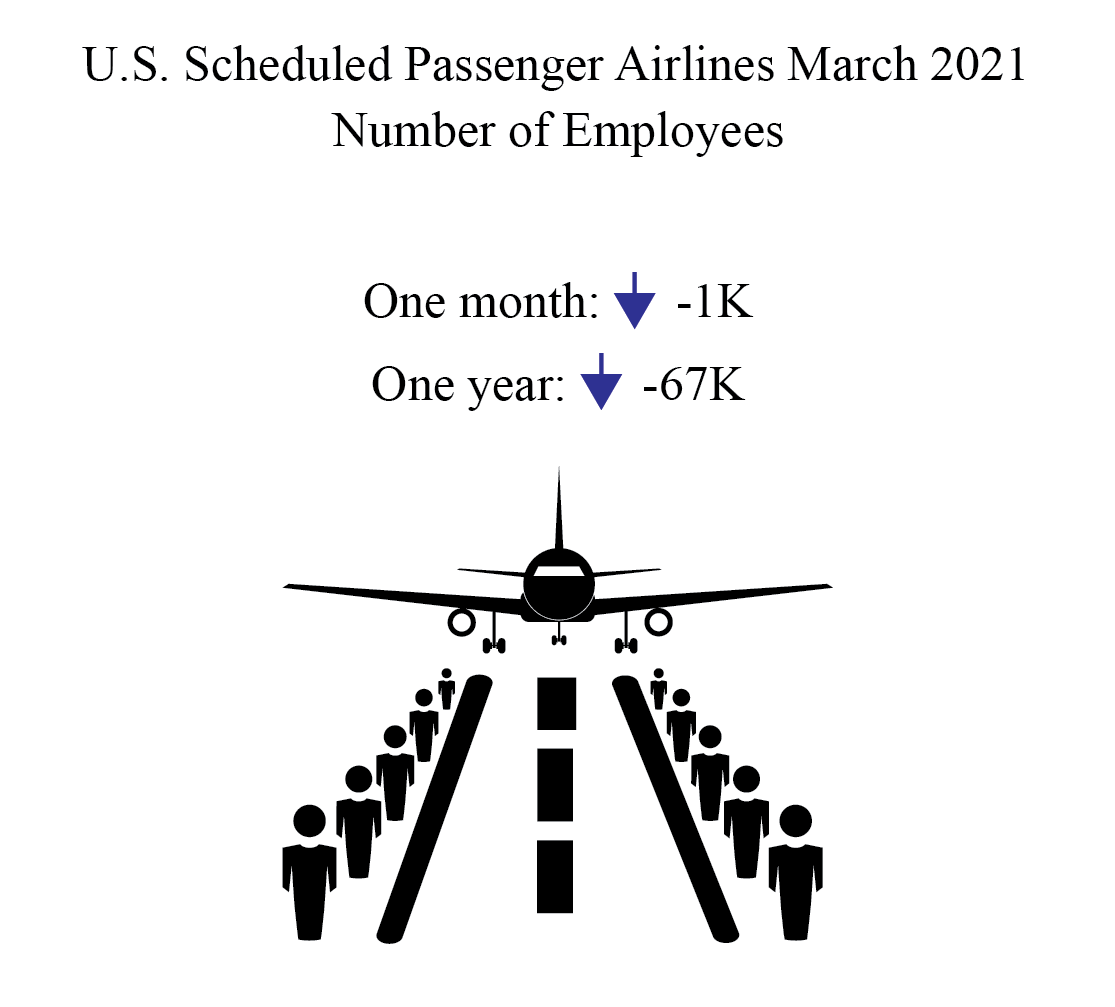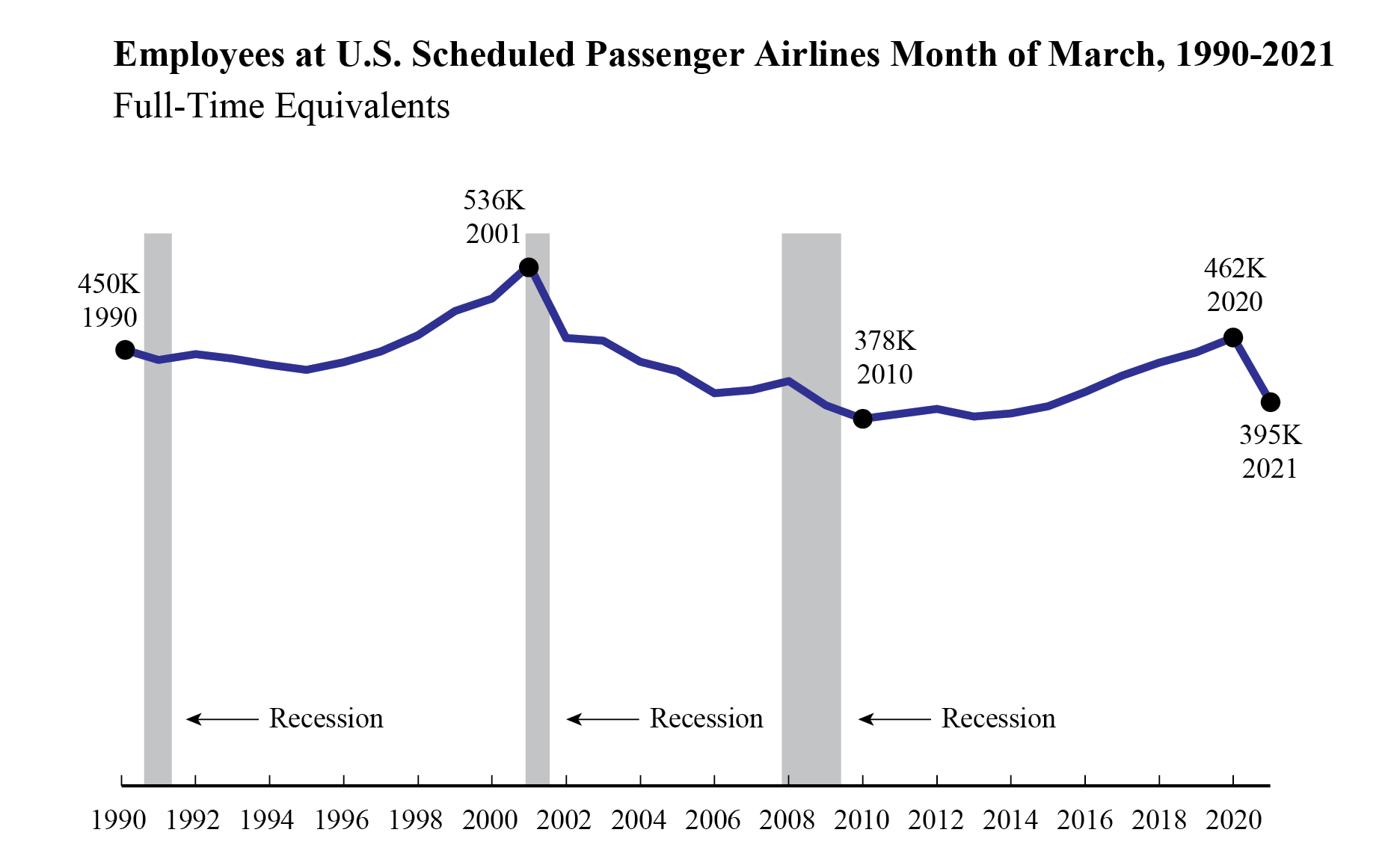Source: US DOT

The 23 U.S. scheduled passenger airlines employed 0.3% fewer full-time equivalents (FTEs) in March 2021 than in February 2021:
- March’s total number of FTEs (395,063) was down 1,126 from February (396,189) and down 66,534, a 14.4% drop from the onset of the pandemic in March 2020 (461,597).
- March 2021 was the lowest FTE total for the month of March since 2015 (390,817).
The decline from February resulted from United Airlines reduction of 6,158 FTEs. Other passenger airlines combined reported an increase in FTEs from February to March.
Scheduled passenger airlines employed 60% of the total airline industry FTEs in March 2021, down from 63% in March 2020. Total industry includes cargo and charter.
Regulations require U.S. airlines to report employment numbers for employees who worked or received pay for any part of the pay period(s) ending nearest the 15th day of the month. U.S. airline employment reports are filed monthly with the Bureau of Transportation Statistics. See the tables that accompany this release on the BTS website for detailed data since 2015 (Tables 1-15) and industry summary monthly data since 1990.

All 23 scheduled service passenger airlines (March):
- 395,063 FTEs
- Down 14.4% (66,534 FTEs) from March 2020 (461,597 FTEs)
- Down 6.4% (27,215 FTEs) from March 2017 (422,278 FTEs)
Four network airlines (March)
- American Airlines, Delta Air Lines, United Airlines, Alaska Airlines
- 236,081 FTEs, 59.8% of total scheduled passenger airline FTEs
- Down 18.9% (55,128 FTEs) from March 2020 (291,209 FTEs)
- Down 14.3% (39,422 FTEs) from March 2017 (275,503 FTEs)
- Down 0.6% (1,341 FTEs) from February 2021 (237,422 FTEs)
Network airlines operate a significant portion of their flights using at least one hub where connections are made for flights to down-line destinations or spoke cities. Note that beginning with January 2018 data, Virgin America’s numbers are included with Alaska Airlines in the network category.
Five low-cost airlines (March)
- Southwest Airlines, JetBlue Airways, Spirit Airlines, Frontier Airlines, Allegiant Air
- 90,697 FTEs, 23% of total scheduled passenger airline FTEs
- Down 8% (7,834 FTEs) from March 2020 (98,531 FTEs)
- Up 3.6% (3,165 FTEs) from March 2017 (87,532 FTEs)
- Down 0.3% (264 FTEs) from February 2021 (90,961) FTEs
Low-cost airlines operate under a low-cost business model, with infrastructure and aircraft operating costs below the overall industry average.
10 regional airlines (March)
- SkyWest Airlines, Envoy Air, Piedmont Airlines, Republic Airlines, Endeavor Air, PSA Airlines, Horizon Air, Mesa Airlines, Air Wisconsin Airlines, GoJet Airlines
- 60,212 FTEs, 15.2% of total scheduled passenger airline FTEs
- Down 3.8% (2,355 FTEs) from March 2020 (62,567 FTEs)
- Up 17% (8,770 FTEs) from March 2017 (51,442 FTEs)
- Up 0.7% (430 FTEs) from February 2021 (59,782 FTEs)
Regional carriers typically provide service from small cities, using primarily regional jets to support the network carriers’ hub and spoke systems.
Top Employers by Group
- Network: American 95,773 FTEs
- Low-Cost: Southwest 56,051 FTEs
- Regional: SkyWest 17,256 FTEs
Four other airlines included in industry totals
Other carriers generally operate within specific niche markets. They are: Hawaiian Airlines, Sun Country Airlines, Silver Airlines and Eastern Airlines.
U.S. cargo airlines reported 255,595 FTEs in March 2021 compared to 254,181 FTEs in February 2021 and 230,474 FTEs in March 2020. Cargo airline FTEs include FedEx ground transportation employees.
